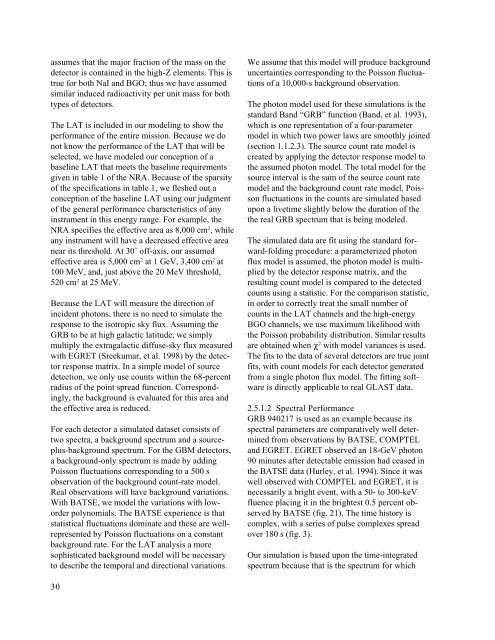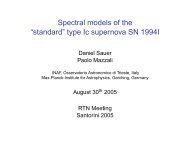Co-Investigator - The Gamma-Ray Astronomy Team - NASA
Co-Investigator - The Gamma-Ray Astronomy Team - NASA
Co-Investigator - The Gamma-Ray Astronomy Team - NASA
- No tags were found...
You also want an ePaper? Increase the reach of your titles
YUMPU automatically turns print PDFs into web optimized ePapers that Google loves.
assumes that the major fraction of the mass on thedetector is contained in the high-Z elements. This istrue for both NaI and BGO; thus we have assumedsimilar induced radioactivity per unit mass for bothtypes of detectors.<strong>The</strong> LAT is included in our modeling to show theperformance of the entire mission. Because we donot know the performance of the LAT that will beselected, we have modeled our conception of abaseline LAT that meets the baseline requirementsgiven in table 1 of the NRA. Because of the sparsityof the specifications in table 1, we fleshed out aconception of the baseline LAT using our judgmentof the general performance characteristics of anyinstrument in this energy range. For example, theNRA specifies the effective area as 8,000 cm 2 , whileany instrument will have a decreased effective areanear its threshold. At 30˚ off-axis, our assumedeffective area is 5,000 cm 2 at 1 GeV, 3,400 cm 2 at100 MeV, and, just above the 20 MeV threshold,520 cm 2 at 25 MeV.Because the LAT will measure the direction ofincident photons, there is no need to simulate theresponse to the isotropic sky flux. Assuming theGRB to be at high galactic latitude, we simplymultiply the extragalactic diffuse-sky flux measuredwith EGRET (Sreekumar, et al. 1998) by the detectorresponse matrix. In a simple model of sourcedetection, we only use counts within the 68-percentradius of the point spread function. <strong>Co</strong>rrespondingly,the background is evaluated for this area andthe effective area is reduced.For each detector a simulated dataset consists oftwo spectra, a background spectrum and a sourceplus-backgroundspectrum. For the GBM detectors,a background-only spectrum is made by addingPoisson fluctuations corresponding to a 500 sobservation of the background count-rate model.Real observations will have background variations.With BATSE, we model the variations with loworderpolynomials. <strong>The</strong> BATSE experience is thatstatistical fluctuations dominate and these are wellrepresentedby Poisson fluctuations on a constantbackground rate. For the LAT analysis a moresophisticated background model will be necessaryto describe the temporal and directional variations.We assume that this model will produce backgrounduncertainties corresponding to the Poisson fluctuationsof a 10,000-s background observation.<strong>The</strong> photon model used for these simulations is thestandard Band “GRB” function (Band, et al. 1993),which is one representation of a four-parametermodel in which two power laws are smoothly joined(section 1.1.2.3). <strong>The</strong> source count rate model iscreated by applying the detector response model tothe assumed photon model. <strong>The</strong> total model for thesource interval is the sum of the source count ratemodel and the background count rate model. Poissonfluctuations in the counts are simulated basedupon a livetime slightly below the duration of thethe real GRB spectrum that is being modeled.<strong>The</strong> simulated data are fit using the standard forward-foldingprocedure: a parameterized photonflux model is assumed, the photon model is multipliedby the detector response matrix, and theresulting count model is compared to the detectedcounts using a statistic. For the comparison statistic,in order to correctly treat the small number ofcounts in the LAT channels and the high-energyBGO channels, we use maximum likelihood withthe Poisson probability distribution. Similar resultsare obtained when2with model variances is used.<strong>The</strong> fits to the data of several detectors are true jointfits, with count models for each detector generatedfrom a single photon flux model. <strong>The</strong> fitting softwareis directly applicable to real GLAST data.2.5.1.2 Spectral PerformanceGRB 940217 is used as an example because itsspectral parameters are comparatively well determinedfrom observations by BATSE, COMPTELand EGRET. EGRET observed an 18-GeV photon90 minutes after detectable emission had ceased inthe BATSE data (Hurley, et al. 1994). Since it waswell observed with COMPTEL and EGRET, it isnecessarily a bright event, with a 50- to 300-keVfluence placing it in the brightest 0.5 percent observedby BATSE (fig. 21). <strong>The</strong> time history iscomplex, with a series of pulse complexes spreadover 180 s (fig. 3).Our simulation is based upon the time-integratedspectrum because that is the spectrum for which30



